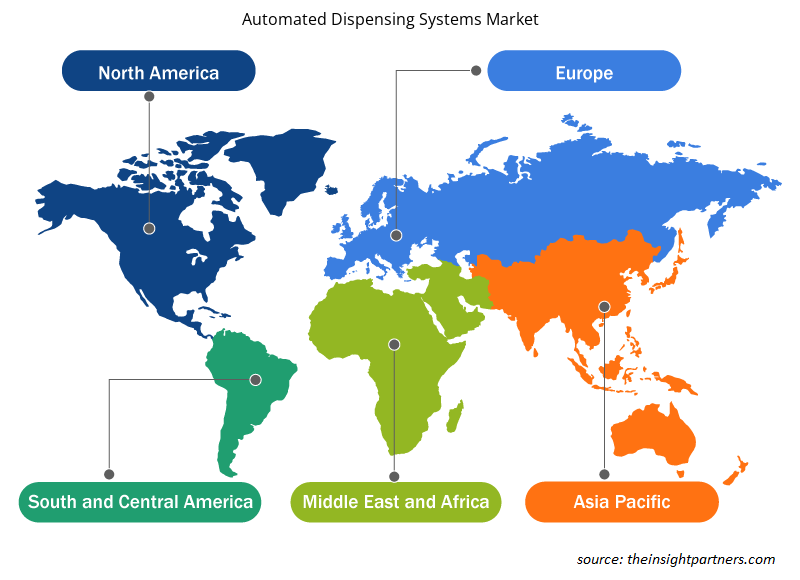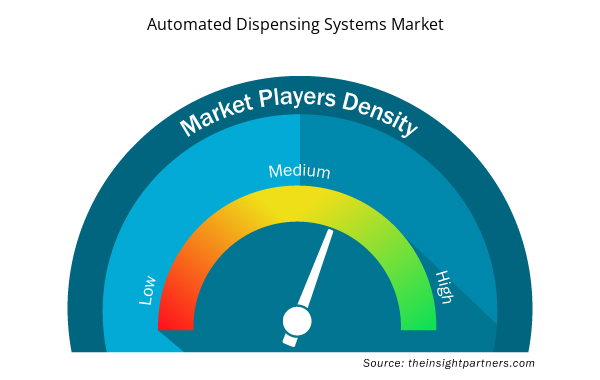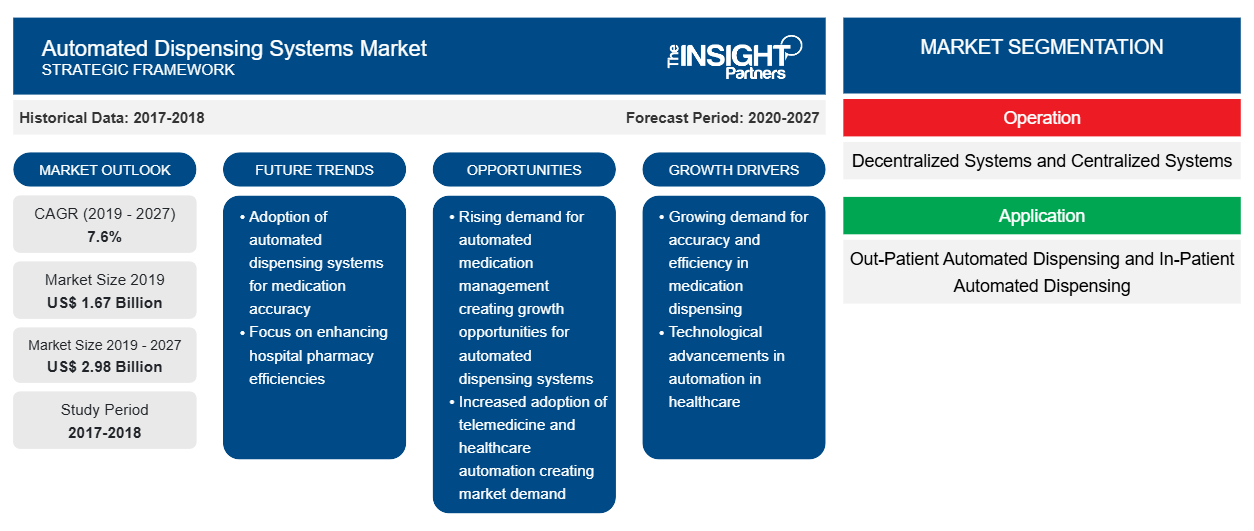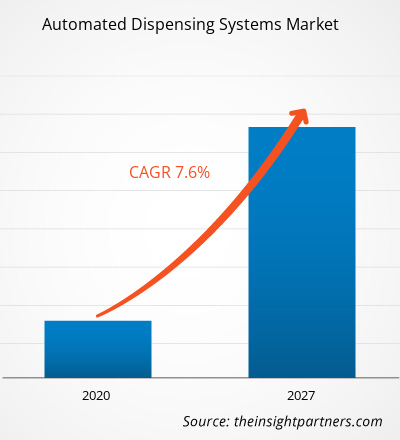Si prevede che il mercato dei sistemi di distribuzione automatizzati raggiungerà i 2.980,38 milioni di dollari entro il 2027, rispetto ai 1.665,78 milioni di dollari del 2019; si stima che crescerà a un CAGR del 7,6% nel periodo 2020-2027.
I sistemi di distribuzione automatizzati, denominati anche armadietti per farmaci automatizzati, sono dispositivi elettronici di stoccaggio e distribuzione dei farmaci, utilizzati principalmente in contesti sanitari. Questi sistemi aiutano a tracciare e controllare la distribuzione dei farmaci; sono protetti da password autenticate e dati biometrici per il controllo dell'inventario e la sicurezza dei farmaci contro i furti. Questi sistemi sono stati evidenziati come uno dei potenziali strumenti per migliorare l'efficienza operativa e la sicurezza dei pazienti. Inoltre, sono ora ampiamente utilizzati in cliniche e case di cura, tra gli altri. I sistemi di distribuzione automatizzati aiutano a trasformare gli ospedali in istituzioni più sicure, efficienti ed efficaci.
Il mercato globale dei sistemi di distribuzione automatizzati è guidato da fattori quali l'aumento degli errori di medicazione e l'aumento della popolazione geriatrica. Tuttavia, i problemi associati ai sistemi di distribuzione automatizzati quali l'inserimento di programmi errati, i guasti delle apparecchiature e altri possono ostacolare la crescita del mercato. Inoltre, i mercati emergenti stanno creando opportunità di crescita per gli operatori del mercato.
Personalizza questo report in base alle tue esigenze
Riceverai la personalizzazione gratuita di qualsiasi report, comprese parti di questo report, o analisi a livello nazionale, pacchetto dati Excel, oltre a usufruire di grandi offerte e sconti per start-up e università
- Scopri le principali tendenze di mercato in questo rapporto.Questo campione GRATUITO includerà analisi di dati che spaziano dalle tendenze di mercato alle stime e alle previsioni.
Approfondimenti di mercato
Aumento degli errori di somministrazione dei farmaci
Una distribuzione di farmaci irrazionale, inappropriata e inefficace può portare a gravi errori di somministrazione che possono danneggiare i pazienti. Alcuni degli errori di somministrazione di farmaci più comuni sono la distribuzione di un farmaco sbagliato, la distribuzione di una quantità di farmaco sbagliata, la distribuzione di un farmaco di potenza sbagliata e l'omissione di un articolo. ~75% degli errori di somministrazione di farmaci sono causati da distrazioni, poiché gli operatori sanitari sono impegnati in più attività come l'esame dei pazienti, i colloqui con i consulenti, i colloqui con i familiari dei pazienti, le conversazioni con i professionisti delle assicurazioni.
Ogni anno, la Food and Drug Administration (FDA) degli Stati Uniti riceve oltre 100.000 segnalazioni associate a errori di somministrazione dei farmaci. Inoltre, secondo lo studio "Medication Errors" pubblicato su StatPearls a giugno 2020, ogni anno negli Stati Uniti muoiono circa 7.000-9.000 persone a causa di errori di somministrazione dei farmaci. Analogamente, secondo le stime pubblicate nello studio "Prevalence and Economic Burden of Medication Errors in the NHS In England" nel 2018, ogni anno si verificano circa 237 milioni di errori di somministrazione dei farmaci nel NHS e le reazioni avverse ai farmaci (ADR) evitabili causano centinaia di decessi.
Approfondimenti basati sulle operazioni
In base al funzionamento, il mercato dei sistemi di distribuzione automatizzati è segmentato in sistemi decentralizzati e sistemi centralizzati. Il segmento dei sistemi centralizzati ha detenuto una quota maggiore del mercato nel 2019 a causa di fattori quali la crescente necessità di ridurre i costi, garantire la disponibilità dei farmaci e modernizzare l'allocazione delle risorse. Inoltre, si prevede che il sistema decentralizzato registrerà un CAGR maggiore nel mercato durante il periodo di previsione.
Approfondimenti basati sulle applicazioni
In base all'applicazione, il mercato dei sistemi di distribuzione automatizzata è segmentato in distribuzione automatizzata per pazienti ricoverati e distribuzione automatizzata per pazienti ambulatoriali. Il segmento della distribuzione automatizzata per pazienti ricoverati ha detenuto una quota maggiore del mercato nel 2019; tuttavia, si prevede che la distribuzione automatizzata per pazienti ambulatoriali registrerà un CAGR più elevato durante il periodo di previsione.
Informazioni basate sull'utente finale
In base all'utente finale, il mercato dei sistemi di distribuzione automatizzati è segmentato in farmacie ospedaliere, farmacie al dettaglio e altri. Il segmento delle farmacie ospedaliere ha detenuto la quota maggiore del mercato nel 2019; tuttavia, si prevede che il segmento delle farmacie al dettaglio registrerà il CAGR più elevato del mercato durante il periodo di previsione.
Lanci di prodotti e approvazioni sono le strategie comunemente adottate dalle aziende per espandere la loro presenza globale e i loro portafogli di prodotti; queste strategie le aiutano a soddisfare la crescente domanda dei consumatori. La collaborazione è una delle principali strategie adottate dagli operatori del mercato dei sistemi di distribuzione automatizzati per ampliare la base clienti in tutto il mondo, il che consente loro anche di mantenere il loro marchio a livello globale.
Approfondimenti regionali sul mercato dei sistemi di distribuzione automatizzati
Le tendenze regionali e i fattori che influenzano il mercato dei sistemi di distribuzione automatizzati durante il periodo di previsione sono stati ampiamente spiegati dagli analisti di Insight Partners. Questa sezione discute anche i segmenti e la geografia del mercato dei sistemi di distribuzione automatizzati in Nord America, Europa, Asia Pacifico, Medio Oriente e Africa e America meridionale e centrale.

- Ottieni i dati specifici regionali per il mercato dei sistemi di distribuzione automatizzati
Ambito del rapporto di mercato sui sistemi di distribuzione automatizzati
| Attributo del report | Dettagli |
|---|---|
| Dimensioni del mercato nel 2019 | 1,67 miliardi di dollari USA |
| Dimensioni del mercato entro il 2027 | 2,98 miliardi di dollari USA |
| CAGR globale (2019 - 2027) | 7,6% |
| Dati storici | 2017-2018 |
| Periodo di previsione | 2020-2027 |
| Segmenti coperti | Per operazione
|
| Regioni e Paesi coperti | America del Nord
|
| Leader di mercato e profili aziendali chiave |
|
Densità degli attori del mercato dei sistemi di distribuzione automatizzati: comprendere il suo impatto sulle dinamiche aziendali
Il mercato dei sistemi di distribuzione automatizzati sta crescendo rapidamente, spinto dalla crescente domanda degli utenti finali dovuta a fattori quali l'evoluzione delle preferenze dei consumatori, i progressi tecnologici e una maggiore consapevolezza dei vantaggi del prodotto. Con l'aumento della domanda, le aziende stanno ampliando le loro offerte, innovando per soddisfare le esigenze dei consumatori e capitalizzando sulle tendenze emergenti, il che alimenta ulteriormente la crescita del mercato.
La densità degli operatori di mercato si riferisce alla distribuzione di aziende o società che operano in un particolare mercato o settore. Indica quanti concorrenti (operatori di mercato) sono presenti in un dato spazio di mercato in relazione alle sue dimensioni o al valore di mercato totale.
Le principali aziende che operano nel mercato dei sistemi di distribuzione automatizzata sono:
- AbbVie Inc.
- Abate
- F. Hoffmann-La Roche Ltd
- Società Bristol-Myers Squibb
- Johnson & Johnson Services, Inc.
Disclaimer : le aziende elencate sopra non sono classificate secondo un ordine particolare.

- Ottieni una panoramica dei principali attori del mercato dei sistemi di distribuzione automatizzati
Mercato globale dei sistemi di distribuzione automatizzati – per operazione
- Sistemi decentralizzati
- Sistemi centralizzati
Mercato globale dei sistemi di distribuzione automatizzati - per applicazione
- Distribuzione automatizzata ambulatoriale
- Distribuzione automatizzata per pazienti ricoverati
Mercato globale dei sistemi di distribuzione automatizzati – per utente finale
- Farmacie al dettaglio
- Farmacie Ospedaliere
- Altri
Mercato dei sistemi di distribuzione automatizzati – per area geografica
America del Nord
- NOI
- Canada
- Messico
Europa
- Francia
- Germania
- Italia
- Regno Unito
- Spagna
- Resto d'Europa
Asia Pacifico (APAC)
- Cina
- India
- Corea del Sud
- Giappone
- Australia
- Resto dell'Asia Pacifica
Medio Oriente e Africa (MEA)
- Sudafrica
- Arabia Saudita
- Emirati Arabi Uniti
- Resto del Medio Oriente e Africa
America del Sud e Centro
- Brasile
- Argentina
- Resto del Sud America
Profili aziendali
- Società Cerner
- Capsa Sanità
- Omnicell, Inc
- BD
- ARxIO
- Sistemi sanitari Accu-Chart Plus, Inc.
- Associati all'innovazione
- Sistemi RxMedic, Inc.
- Società di Logistica Svizzera Ltd.
- Willach Farmacia Solutions GmbH
- Analisi storica (2 anni), anno base, previsione (7 anni) con CAGR
- Analisi PEST e SWOT
- Valore/volume delle dimensioni del mercato - Globale, regionale, nazionale
- Industria e panorama competitivo
- Set di dati Excel



Report Coverage
Revenue forecast, Company Analysis, Industry landscape, Growth factors, and Trends

Segment Covered
This text is related
to segments covered.

Regional Scope
North America, Europe, Asia Pacific, Middle East & Africa, South & Central America

Country Scope
This text is related
to country scope.
Domande frequenti
The anti-viral therapiesmarket majorly consists of the players such as Cerner Corporation, Capsa Healthcare, Omnicell, Inc, BD, ARxIUM, Accu-Chart Plus Healthcare Systems, Inc, Innovation Associates, RxMedic Systems, Inc, Swiss log Holding Ltd and Willach Pharmacy Solutions GmbHamongst others.
The factors that are driving growth of the market are increasing medication errors, increasing prevalence of chronic diseases and rising geriatric population. Moreover, emerging markets is expected to offer lucrative opportunities for the growth of the market.
Automated dispensing system, also termed as automated drug cabinet, is an electronic drug storage and dispensing device primarily used in health care settings. These systems aid in tracking and controlling the drug distribution and are secured with authenticated passwords and biometrics for inventory control and security of the drugs. These systems have been recommended as one of the potential instruments to improve efficiency and patient safety, and they are now widely used in many hospitals, for instance in clinics, nursing homes. Automated dispensing system helps to transform hospitals into safer, more efficient and more effective institutions.
Trends and growth analysis reports related to Life Sciences : READ MORE..
The List of Companies - Automated Dispensing Systems Market
- AbbVie Inc.
- Abbott
- F. Hoffmann-La Roche Ltd
- Bristol-Myers Squibb Company
- Johnson & Johnson Services, Inc.
- Merck and Co., Inc.
- Gilead Sciences, Inc.
- GlaxoSmithKline plc
- Aurobindo Pharma
- AstraZeneca
The Insight Partners performs research in 4 major stages: Data Collection & Secondary Research, Primary Research, Data Analysis and Data Triangulation & Final Review.
- Data Collection and Secondary Research:
As a market research and consulting firm operating from a decade, we have published and advised several client across the globe. First step for any study will start with an assessment of currently available data and insights from existing reports. Further, historical and current market information is collected from Investor Presentations, Annual Reports, SEC Filings, etc., and other information related to company’s performance and market positioning are gathered from Paid Databases (Factiva, Hoovers, and Reuters) and various other publications available in public domain.
Several associations trade associates, technical forums, institutes, societies and organization are accessed to gain technical as well as market related insights through their publications such as research papers, blogs and press releases related to the studies are referred to get cues about the market. Further, white papers, journals, magazines, and other news articles published in last 3 years are scrutinized and analyzed to understand the current market trends.
- Primary Research:
The primarily interview analysis comprise of data obtained from industry participants interview and answers to survey questions gathered by in-house primary team.
For primary research, interviews are conducted with industry experts/CEOs/Marketing Managers/VPs/Subject Matter Experts from both demand and supply side to get a 360-degree view of the market. The primary team conducts several interviews based on the complexity of the markets to understand the various market trends and dynamics which makes research more credible and precise.
A typical research interview fulfils the following functions:
- Provides first-hand information on the market size, market trends, growth trends, competitive landscape, and outlook
- Validates and strengthens in-house secondary research findings
- Develops the analysis team’s expertise and market understanding
Primary research involves email interactions and telephone interviews for each market, category, segment, and sub-segment across geographies. The participants who typically take part in such a process include, but are not limited to:
- Industry participants: VPs, business development managers, market intelligence managers and national sales managers
- Outside experts: Valuation experts, research analysts and key opinion leaders specializing in the electronics and semiconductor industry.
Below is the breakup of our primary respondents by company, designation, and region:

Once we receive the confirmation from primary research sources or primary respondents, we finalize the base year market estimation and forecast the data as per the macroeconomic and microeconomic factors assessed during data collection.
- Data Analysis:
Once data is validated through both secondary as well as primary respondents, we finalize the market estimations by hypothesis formulation and factor analysis at regional and country level.
- Macro-Economic Factor Analysis:
We analyse macroeconomic indicators such the gross domestic product (GDP), increase in the demand for goods and services across industries, technological advancement, regional economic growth, governmental policies, the influence of COVID-19, PEST analysis, and other aspects. This analysis aids in setting benchmarks for various nations/regions and approximating market splits. Additionally, the general trend of the aforementioned components aid in determining the market's development possibilities.
- Country Level Data:
Various factors that are especially aligned to the country are taken into account to determine the market size for a certain area and country, including the presence of vendors, such as headquarters and offices, the country's GDP, demand patterns, and industry growth. To comprehend the market dynamics for the nation, a number of growth variables, inhibitors, application areas, and current market trends are researched. The aforementioned elements aid in determining the country's overall market's growth potential.
- Company Profile:
The “Table of Contents” is formulated by listing and analyzing more than 25 - 30 companies operating in the market ecosystem across geographies. However, we profile only 10 companies as a standard practice in our syndicate reports. These 10 companies comprise leading, emerging, and regional players. Nonetheless, our analysis is not restricted to the 10 listed companies, we also analyze other companies present in the market to develop a holistic view and understand the prevailing trends. The “Company Profiles” section in the report covers key facts, business description, products & services, financial information, SWOT analysis, and key developments. The financial information presented is extracted from the annual reports and official documents of the publicly listed companies. Upon collecting the information for the sections of respective companies, we verify them via various primary sources and then compile the data in respective company profiles. The company level information helps us in deriving the base number as well as in forecasting the market size.
- Developing Base Number:
Aggregation of sales statistics (2020-2022) and macro-economic factor, and other secondary and primary research insights are utilized to arrive at base number and related market shares for 2022. The data gaps are identified in this step and relevant market data is analyzed, collected from paid primary interviews or databases. On finalizing the base year market size, forecasts are developed on the basis of macro-economic, industry and market growth factors and company level analysis.
- Data Triangulation and Final Review:
The market findings and base year market size calculations are validated from supply as well as demand side. Demand side validations are based on macro-economic factor analysis and benchmarks for respective regions and countries. In case of supply side validations, revenues of major companies are estimated (in case not available) based on industry benchmark, approximate number of employees, product portfolio, and primary interviews revenues are gathered. Further revenue from target product/service segment is assessed to avoid overshooting of market statistics. In case of heavy deviations between supply and demand side values, all thes steps are repeated to achieve synchronization.
We follow an iterative model, wherein we share our research findings with Subject Matter Experts (SME’s) and Key Opinion Leaders (KOLs) until consensus view of the market is not formulated – this model negates any drastic deviation in the opinions of experts. Only validated and universally acceptable research findings are quoted in our reports.
We have important check points that we use to validate our research findings – which we call – data triangulation, where we validate the information, we generate from secondary sources with primary interviews and then we re-validate with our internal data bases and Subject matter experts. This comprehensive model enables us to deliver high quality, reliable data in shortest possible time.


 Ottieni un campione gratuito per questo repot
Ottieni un campione gratuito per questo repot